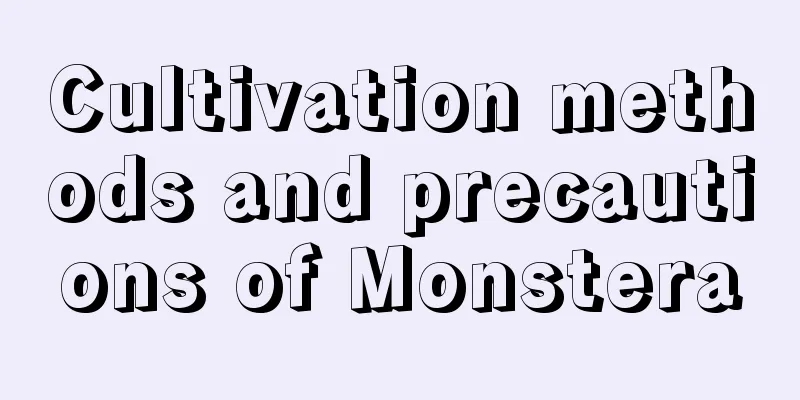Cultivation methods and precautions of Monstera

|
Monstera is named after its leaves which resemble a turtle's back. It not only symbolizes health and longevity, but can also purify the air. Therefore, it is loved by many flower lovers. As a large indoor potted foliage plant, Monstera is easy to maintain. Many people grow Monstera at home. Let's talk about the cultivation methods and precautions of Monstera. 1. Temperature management Monstera is best grown in an environment between 15-28 degrees. When the temperature is low, the Monstera should be moved indoors or warming measures should be taken; when the temperature is high, it should be shaded and ventilation should be increased. 2. Choose the soil The potting soil should be loose, breathable, acidic soil. It can be mixed with humus soil, garden soil, and coarse river sand in a ratio of 2:2:1. It is best to add some base fertilizer. Manure, bone meal, and controlled-release fertilizer can be used as base fertilizer. Just add a little bit of it. Too much base fertilizer will burn the roots. 3. Lighting management Monstera is shade-tolerant and should be placed in a diffuse light or bright environment to avoid strong sunlight exposure. However, in order to ensure that the leaves are green and shiny, try to keep it close to the sun. 4. Watering management Monstera likes a humid environment, but avoids waterlogging. Normally, watering should be done when the soil is dry and when the air humidity is too low, you need to spray water mist on the leaves of Monstera. 5. Fertilization management Monstera likes fertilizer. It should be applied with a 2:1:1 compound fertilizer of nitrogen, phosphorus and potassium once every half a month in spring, summer, autumn and winter. When the temperature is too high in summer, especially over 35 degrees, or too low in winter, Monstera does not need to be fertilized. 6. Pruning and propagation If you want to propagate Monstera, you can do it by cuttings. After completion, it needs to be placed in a cool and ventilated environment to accelerate seedling growth, and diseased, weak and dead branches should be pruned in time. 7. Pest and disease control Monstera is susceptible to diseases and pests during its growth period. The most common disease is gray spot, which can be controlled by spraying 1000 times diluted 70% thiophanate or 0.5% equal-volume Bordeaux mixture. In addition, plant maintenance needs to be strengthened. Common insect pests are scale insects, which can be controlled by spraying 1000 times diluted 40% oxydemeton-methyl emulsion. That’s it |
<<: Why does Forsythia bloom but not bear fruit? Where does it usually bear more fruit?
Recommend
What is the best month to plant yam beans?
When to plant yam beans Yam beans are usually pla...
Management of the flowering period of large-flowered cymbidium (how long is the flowering period, can fertilizer be applied during flowering)
1. How long is the flowering period of cymbidium?...
How to water Monstera
Summer watering Monstera prefers a relatively hum...
The efficacy and function of pearl spider plant
1. Ornamental value As a kind of succulent, the r...
Is a cactus suitable for a deep or shallow pot?
Should cactus be potted in a deep or shallow pot?...
The efficacy and function of Astragalus
1. Regulate blood pressure Taking Astragalus in m...
What fertilizer to use for lucky bamboo
1. What fertilizer to use for fertilization 1. So...
Onion pot planting methods and precautions
When to plant onion pots There are many varieties...
Six times the profit, prefer yin or yang
Six times the profit, prefer yin or yang Liubeili...
How to prevent the occurrence of deformed strawberry fruits (causes and preventive measures for deformed strawberry fruits)
Deformed strawberry fruits are a rather annoying ...
Where do cauliflower seeds come from?
Where do cauliflower seeds come from? Cauliflower...
The difference between white clover and alfalfa, is white clover a four-leaf clover?
1. Is white clover a four-leaf clover? White clov...
Is geranium suitable for growing at home? (Cultivation methods and precautions for potted geraniums)
Can I grow geraniums at home? Geranium has a beau...
How to grow a fortune tree so that it grows well How to cultivate a fortune tree so that it survives
The money tree symbolizes attracting wealth and f...
Does Jasper Flower prefer shade or sun?
Does Jasper Flower prefer shade or sun? Jade flow...









